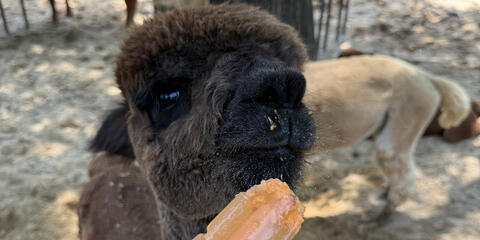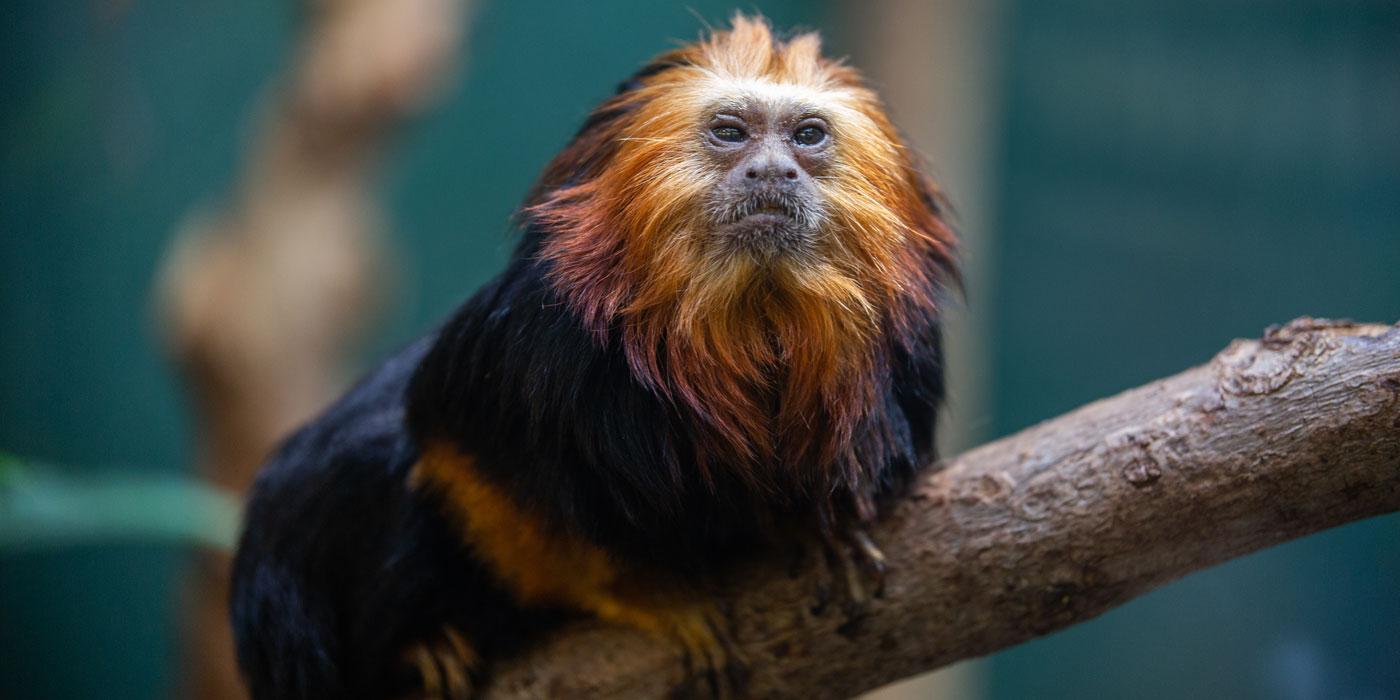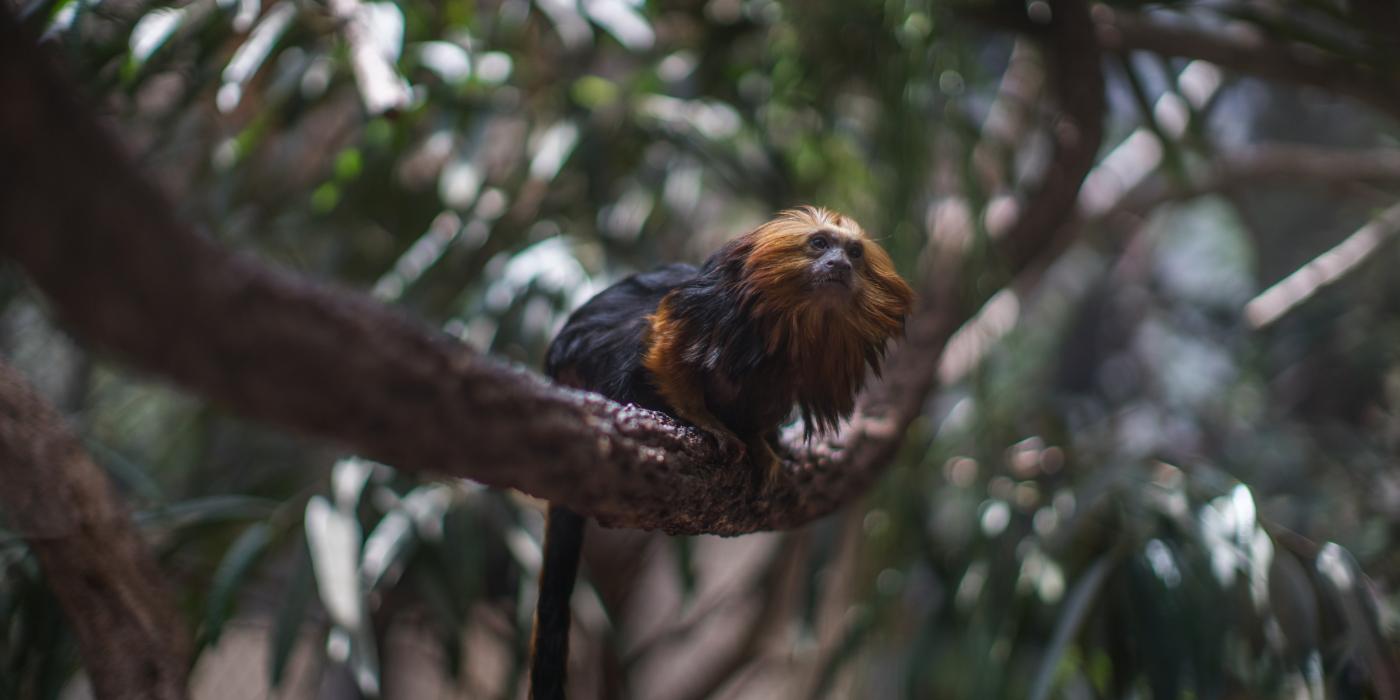Physical Description
Golden-headed lion tamarins' resemble other species of tamarins; they have relatively large canines with a small head and body. Males and females are similar in appearance and size.
Like other tamarins and marmosets, golden-headed lion tamarins have non-opposable thumbs and claw-like nails on all digits except for the big toe. They also have long digits used for forging for small insects and vertebrates.
Size
Golden-headed lion tamarins weigh about 17 to 24.7 ounces (500 to 700 grams) and measure 8 to 13 inches (20 to 34 centimeters) in body length plus a 12 to 15 inch (32 to 40 centimeter) long tail.
Native Habitat
Golden-headed lion tamarins are found only in Brazil. Due to habitat destruction, they are confined to the southern part of the state of Bahia, Brazil. They live in the tall evergreen broadleaf tropical forests and semi-deciduous forests along the Atlantic coast from 10 to 33 feet (3 to 10 meters) in the canopy.
Lifespan
The median life expectancy for golden-headed lion tamarins is eight years, but they can live even longer in human care.
Communication
These tamarins communicate in a number of ways; vocalizations among golden-headed lion tamarins are based on activity and behavior. Long calls maintain pair bonds and signal a group's presence in their territory. Trills are used when activity is solitary, and they make clucks while foraging. When two individuals make contact, they whine.
Individuals scent mark using glands in their pubic region and throat. They rub these glands against a surface and deposit secretions by pulling themselves along or by pushing themselves with their feet. They signal aggression when their hair stands on end.
Food/Eating Habits
Golden-headed lion tamarins are frugivorous, eating mostly soft, sweet fruits. They will also eat flowers, nectar, insects and small invertebrates. These tamarins may also eat exudates (gums) opportunistically, especially the large quantities sometimes exuded from wounds in wild cashew trees and beans from leguminous trees. They do not eat leaves.
Recent research has demonstrated that marmosets and tamarins play a significant role in seed dispersal. Many of the fruits they eat have seeds that pass through the monkey's digestive tract unharmed and end up deposited well away from the parent plant. The seeds may also help to dislodge intestinal parasites in the monkey's digestive tract. Tamarins and marmosets spend about 25 to 30 percent of their time foraging for animal prey.
Food sharing is more important in the lion tamarins than in other marmosets and tamarins, and helps maintain social structure. This species may form mixed species groups with Wied's black-tufted-ear marmoset. They do not compete with each other because they forage in separate areas and occupy different niches in the environment. Golden-headed lion tamarins forage in the upper levels of the forest, while Wied's black-tufted-ear marmosets forage in the middle and lower levels of the forest. Golden-headed lion tamarins also prefer to forage in epiphytic bromeliads.
At the Smithsonian's National Zoo, their diet includes canned marmoset diet, bananas, grapes, apples, string beans, fruit and mealworms.
Sleep Habits
This species sleeps in tree holes during the night; they are arboreal and diurnal. Golden-headed lion tamarins will use the same tree hole for up to six nights in a row.
Social Structure
They live in family groups of five to seven animals; a typical family group consists of a mated pair plus their youngest offspring. In tamarin society, males and females mate for life and take equal part in raising their young. Adults of the same sex are very aggressive toward one another in defense of territory.
Reproduction and Development
Golden-headed lion tamarin reproduction is similar to other marmosets and tamarins. Males and females reach sexually maturity at different times: males at about 2 years, and females at 1.5 years. Upon reaching sexual maturity, females begin an estrous cycle of two to three weeks. Their gestation period lasts about four months. Golden-headed lion tamarins generally reproduce only once a year in the wild.
Conservation Efforts
Deforestation and habitat loss due to agriculture (including cattle ranching and cocoa plantations) and sawmills driven by socio-economic changes, is the greatest threat facing golden-headed lion tamarins. Their original range spanned forests that stretched from the central Bahian plateau to within a few miles of the coast. This forest is now severely fragmented and has resulted in population isolation.
Only one to five percent of Brazil's original Atlantic forest has been left standing. Palm oil and coconut production has also expanded from the previously dominant cocoa plantations. After being pushed out of their native forests, golden-headed lion tamarins have started to move into cocoa plantation forests. Unfortunately, many plantation owners have complained that this movement is adversely affecting their crop.
Fire and illegal removal of animals also threatens the remaining populations.
During the late 1980s the Brazilian Institute for the Environment established the International Committee for the Recovery and Management of the species. The resulting recovery was highly successful, and the committee established a breeding program and studbook for the species. Extensive surveys were undertaken in 1994, within the species estimated range, to assess the conservation status of wild populations of this tamarin.
Golden-headed lion tamarins are still included on the Brazilian Official List of Species Threatened with Extinction. They also occur in protected areas and have a well-managed breeding program derived from animals confiscated from the illegal trade. This group has become an important genetic reservoir. There are now believed to be more than 6,000 golden-headed lion tamarins in the wild.
Help this Species
- Reduce, reuse and recycle — in that order! Cut back on single-use goods, and find creative ways to reuse products at the end of their life cycle. Choose recycling over trash when possible.
- Practice ecotourism by being an advocate for the environment when you’re on vacation. During your travels, support, visit or volunteer with organizations that protect wildlife. Shop smart too! Avoid buying products made from animals, which could support poaching and the illegal wildlife trade.
- Are you a student? Did you love what you learned about this animal? Make it the topic of your next school project, or start a conservation club at your school. You'll learn even more and share the importance of saving species with classmates and teachers, too.
Animal News

Keeping the Farm Animals Cool with Frozen Treats





